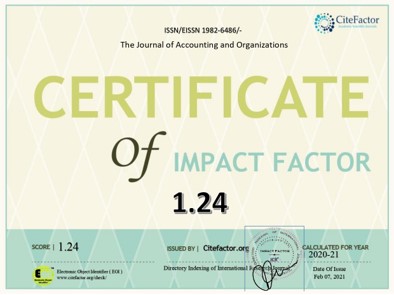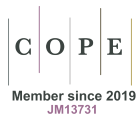Effects of corruption on stock exchanges in the 2008 Financial Crisis
DOI:
https://doi.org/10.11606/issn.1982-6486.rco.2019.158490Keywords:
Corruption, 2008 Financial Crisis, Institucional CorruptionAbstract
The purpose of this paper is to determine if the different levels of corruption reflected in the behavior of stock exchanges around the World in the 2008 Financial Crisis. Institutional Choice Theory indicates that, in the period before the Crisis, financial practices that provided large gains and concealed high risk were widespread. We used information from the Transparency International and the World Bank on perceived corruption and the level of governance on a final sample of 56 (fifty-six) countries. For these countries, we identified the main stock exchange and, for each one, the main burse index, whose daily quoted prices we gathered for the period from 2007 to 2009. The main results showed that in countries with greater perceived corruption and lower governance, the 2008 Financial Crisis presented a larger accumulated decrease of the stock exchanges followed by deeper structural breakdown, increased volatility and lower predictability of the drop. We conclude that, in general, the effects of the 2008 Financial Crisis were different according to the level of perceived corruption and governance, being more serious in countries where corruption was more institutionalized.
Downloads
References
Saharan Africa. Resource & Engineering Economics Publications Services. DOI: http://dx.doi.org/10.2139/
ssrn.1359944.
Bacen (2008) Relatório de estabilidade financeira. Brasília – DF, 3(7), 140p.
Boubaker, S., Jouini, J., & Lahiani, A. (2016). Financial contagion between the US and selected developed and
emerging countries: The case of the subprime crisis. The Quarterly Review of Economics and Finance, 61,
14-28. DOI: https://doi.org/10.1016/j.qref.2015.11.001.
Campbell, J., Lo, A W., Mackinlay, A. (1997). The Econometric of Financial Markets. New Jersey: Princeton
University Press.
Clemente, A., Juaniha, A. M., & Ribeiro, F. (2017). Efeitos Da Crise Financeira De 2008 E Da Adoção Das IFRS
Sobre O Matching Principle: Um Estudo Sobre As Empresas Industriais Listadas Na Bm&Fbovespa (2005–
2015). Contabilidade Vista & Revista, 28(3), 133-157.
Corsetti, G., Pesenti, P., & Roubini, N. (1999). What caused the Asian currency and financial crisis?. Japan and the
world economy, 11(3), 305-373. DOI: https://doi.org/10.1016/S0922-1425(99)00019-5.
Collier, M. W. (2002). Explaining corruption: An institutional choice approach. Crime, Law and Social Change,
38(1), 1-32.
Dong, B., Dulleck, U., & Torgler, B. (2012). Conditional corruption. Journal of Economic Psychology, 33(3), 609-
627. DOI: https://doi.org/10.1016/j.joep.2011.12.001.
Dong, B., & Torgler, B. (2013). Causes of corruption: Evidence from China. China Economic Review, 26, 152-
169. DOI: https://doi.org/10.1016/j.chieco.2012.09.005.
Dzhumashev, R. (2014). Corruption and growth: The role of governance, public spending, and economic
development. Economic Modelling, 37, 202-215. DOI: https://doi.org/10.1016/j.econmod.2013.11.007.
Ffrench-Davis, R. (2010). O Impacto da crise global na América Latina. Revista Tempo do Mundo – Instituto de
Economia Aplicada (IPEA), 2 (89-104).
Glaeser, E. L., & Saks, R. E. (2006). Corruption in America. Journal of public Economics, 90(6-7), 1053-1072.
DOI: https://doi.org/10.3386/w10821.
Gugiu, M. R., & Gugiu, P. C. (2016). Economic Crisis and Corruption in the European Union. Journal of Methods
and Measurement in the Social Sciences, 7(1), 1-22. DOI: https://doi.org/10.2458/v7i1.19398.
Gujarati, D. N., & Porter, D. C. (2011). Econometria Básica. Amgh Editora.
Irwin, N. (2014). Os grandes alquimistas financeiros: as histórias secretas dos presidentes dos três principais
bancos centrais do mundo em uma economia em chamas. Rio de Janeiro: Elsevier.
Ito, T., & Hashimoto, Y. (2005). High‐frequency contagion of currency crises in Asia. Asian Economic Journal,
19(4), 357-381. DOI: https://doi.org/10.3386/w9376.
Ivlevs, A., & Hinks, T. (2013). Global economic crisis and corruption experience: Evidence from transition
economies. Economics Working Paper Series, University of the West of England.
Jain, P. K., Kuvvet, E., & Pagano, M. S. (2017). Corruption’s impact on foreign portfolio investment. International
Business Review, 26(1), 23-35. DOI: https://doi.org/10.1016/j.ibusrev.2016.05.004.
Judge, W. Q., McNatt, D. B., & Xu, W. (2011). The antecedents and effects of national corruption: A meta-analysis.
Journal of World Business, 46(1), 93-103. DOI: https://doi.org/10.1016/j.jwb.2010.05.021.
Kaufmann, D. (2009). Corruption and the Global Financial Crisis. Disponível em: https://www.brookings.edu/
opinions/corruption-and-the-global-financial-crisis/. Acesso em outubro/2019.
Kaufmann, D., Kraay, A., & Mastruzzi, M. (2011). The worldwide governance indicators: methodology
and analytical issues. Hague Journal on the Rule of Law, 3(2), 220-246. DOI: https://doi.org/10.1017/
S1876404511200046.
Kenourgios, D., & Dimitriou, D. (2015). Contagion of the Global Financial Crisis and the real economy: A regional
analysis. Economic Modelling, 44, 283-293. DOI: https://doi.org/10.1016/j.econmod.2014.10.048.
Kobayashi, K., Nakajima, T., & Inaba, M. (2012). Collateral constraint and news-driven cycles. Macroeconomic
Dynamics, 16(5), 752-776. DOI: https://doi.org/10.1017/S1365100510000829.
Lee, W. S., & Guven, C. (2013). Engaging in corruption: The influence of cultural values and contagion effects at the microlevel. Journal of Economic Psychology, 39, 287-300. DOI: https://doi.org/10.1016/j.joep.2013.09.006.
Luchtenberg, K. F., & Vu, Q. V. (2015). The 2008 financial crisis: Stock market contagion and its determinants.
Research in International Business and Finance, 33, 178-203. DOI: https://doi.org/10.1016/j.ribaf.2014.09.007
Mackinlay, A. (1997). Event Studies in Economic and Finance. Journal of Economic Literature, 35, p. 13-39.
Marino, P. D. B. L. P., Soares, R. A., De Luca, M. M. M., & de Vasconcelos, A. C. (2016). Indicadores de governança
mundial e sua relação com os indicadores socioeconômicos dos países do Brics. Revista de Administração
Pública, 50(5), 721-744. DOI: http://dx.doi.org/10.1590/0034-7612144359.
Morales, L., & Andreosso-O’Callaghan, B. (2012). The current global financial crisis: Do Asian stock markets
show contagion or interdependence effects?. Journal of Asian Economics, 23(6), 616-626. DOI: https://doi.
org/10.1016/j.asieco.2012.09.002.
Mironov, M. (2015). Should one hire a corrupt CEO in a corrupt country?. Journal of Financial Economics,
117(1), 29-42. DOI: https://doi.org/10.1016/j.jfineco.2014.03.002.
Ortiz-Ospina, E, Roser, M. (2016). Corruption. Disponível em: https://ourworldindata.org/corruption. Acesso:
Abril 2019.
Paldam, M. (2002). The cross-country pattern of corruption: economics, culture and the seesaw dynamics. European Journal of Political Economy, 18(2), 215-240. DOI: https://doi.org/10.1016/S0176-2680(02)00078-2.
Paulson Jr, H. M. (2010). A beira do abismo financeiro: a corrida para salvar a economia global do colapso. São
Paulo: Campus.
Paserman, M. (2017). Comovement or safe haven? The effect of corruption on the market risk of sovereign bonds of emerging economies during financial crises. Journal of International Money and Finance, 76, 106-132.
DOI: https://doi.org/10.1016/j.jimonfin.2017.06.001.
Righi, B. M., & Ceretta, P. S. (2013). Efeito da crise de 2007/2008 na transmissão internacional de volatilidade
no mercado de capitais brasileiro. REAd-Revista Eletrônica de Administração, 19(2). DOI: http://dx.doi.
org/10.1590/S1413-23112013000200005.
Samarakoon, L. P. (2011). Stock market interdependence, contagion, and the US financial crisis: The case of
emerging and frontier markets. Journal of International Financial Markets, Institutions and Money, 21(5),
724-742.
Salmon, T. C., & Serra, D. (2017). Corruption, social judgment and culture: An experiment. Journal of Economic
Behavior & Organization, 142, 64-78. DOI: https://doi.org/10.1016/j.jebo.2017.06.004.
Smick, D.M., (2009). O mundo é curvo: Perigos ocultos para a economia mundial. Rio de Janeiro: Best Seller.
Smith, J. D. (2016). US political corruption and firm financial policies. Journal of Financial Economics, 121(2),
350-367. DOI: https://doi.org/10.1016/j.jfineco.2015.08.021.
Shiller, R. J., (2012). Finanças para uma boa sociedade: Como o capitalismo financeiro pode contribuir para um
mundo mais justo. Rio de Janeiro: Elsevier.
Shikida, C., Paiva, G. L., & Junior, A. F. A. (2016). Análise de quebras estruturais na série do preço do boi gordo
no Estado de São Paulo. Economia Aplicada, 20(2), 265-286.
Transparency International. (2012). Greece: The Cost of a Bribe. Disponível em:< https://www.transparency.org/
news/feature/greece_the_cost_of_a_bribe>. Acesso em outubro/2019.
Transparency International. (2018). Disponível em: <https://www.transparency.org>. Acesso em dezembro/2018.
Vale, S. R. (2018). Macroeconomia e governança global: um casamento incompleto. Relações Internacionais no
Mundo Atual, 1(24).
Downloads
Published
Issue
Section
License
The RCO adopts the Free Open Access policy, under the standard Creative Commons agreement (CC BY-NC-ND 4.0). The agreement provides that:
- Submission of text authorizes its publication and implies commitment that the same material is not being submitted to another journal. The original is considered definitive.
- Authors retain the copyright and grant the journal the right of first publication, with the work simultaneously licensed under the Creative Commons Attribution License which allows the sharing of the work with acknowledgment of authorship and initial publication in this journal.
- Authors are authorized to take additional contracts separately, for non-exclusive distribution of the version of the work published in this journal (e.g. publish in an institutional repository or as a book chapter), with necessary recognition of authorship and initial publication in this journal.
- Authors are allowed and encouraged to publish and distribute their work online (e.g. in institutional repositories or on their personal page) before or during the editorial process, as this can generate productive changes as well as increase the impact and citation of published work (See The Effect of Free Access).
- The journal does not pay copyright to the authors of the published texts.
- The journal's copyright holder, except those already agreed in the Free Open Access Agreement (CC BY-NC-ND 4.0), is the Accounting Department of the Faculty of Economics, Administration and Accounting of Ribeirão Preto of the University of São Paulo.
No submission or publication fees are charged.
Up to 4 authors per article are accepted. Exceptionally duly justified cases may be reviewed by the Executive Committee of the RCO. Exceptional cases are considered as: multi-institutional projects; manuscripts resulting from the collaboration of research groups; or involving large teams for evidence collection, construction of primary data, and comparative experiments.
It is recommended that the authorship be ordered by contribution of each of the individuals listed as authors, especially in the design and planning of the research project, in obtaining or analyzing and interpreting data, and writing. Authors must declare the actual contributions of each author, filling the letter to the editor, at the beginning of the submission, taking responsibility for the information given.
Authors are allowed to change throughout the evaluation process and prior to the publication of the manuscript. The Authors should indicate the composition and final order of authorship in the document signed by all those involved when accepted for publication. If the composition and authoring order is different than previously reported in the system, all previously listed authors should be in agreement.
In the case of identification of authorship without merit or contribution (ghost, guest or gift authorship), the RCO follows the procedure recommended by COPE.







